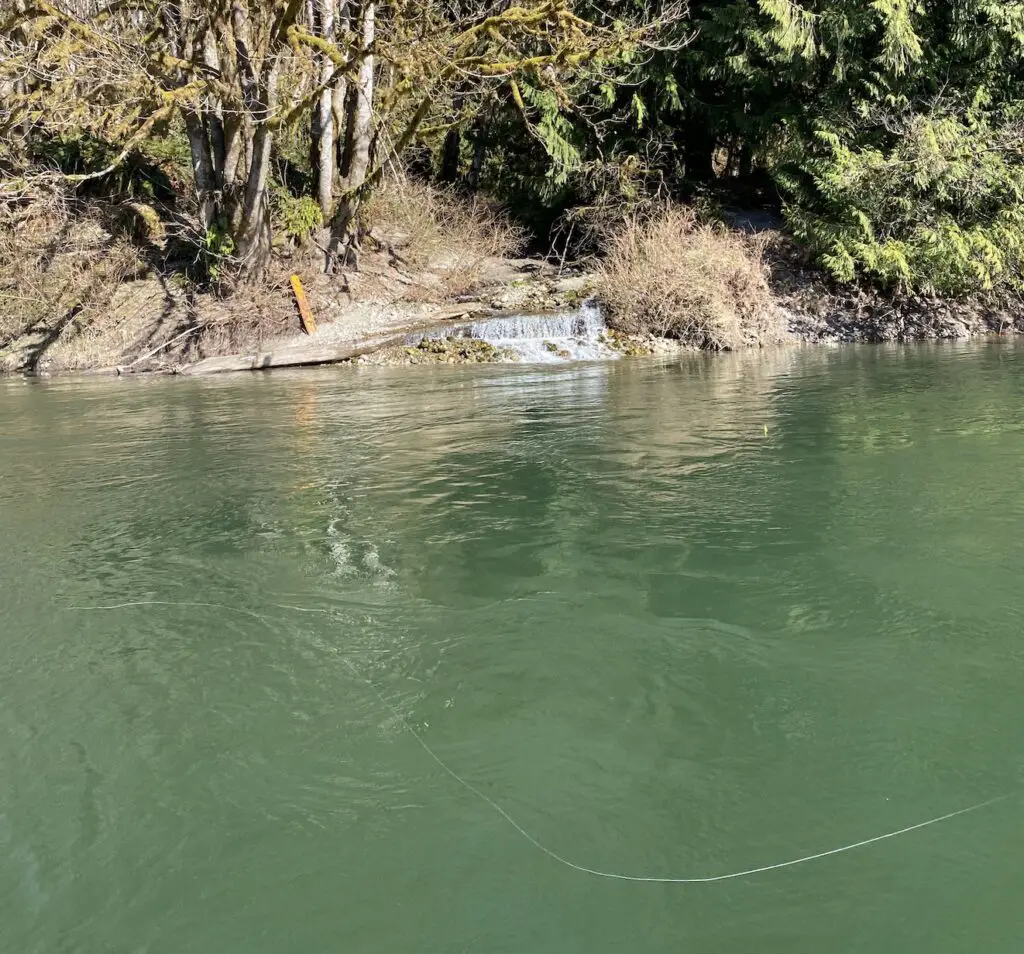
The Skagit River is the premier river of the north cascades draining a massive watershed and providing up to 80% of the influx of freshwater into the Puget Sound.
Winding through miles of mountainous terrain, foothills, and farmland before dumping into Skagit Bay between Stanwood and La Conner.
This unique Skagit River page is meant to provide you with a one-stop resource for planning a fishing trip to the Skagit River.
Many references on the internet to Skagit River fishing will be filled with out-of-date information, but this page is updated and fed automatically based on data being published by a variety of sources to help you have success fishing on the Skagit River.
Whether you are reading this to prepare for your first-ever fishing trip to the Skagit River or this is your local favorite place to fish, I hope you find these resources helpful.
Current River Conditions on the Skagit River
If you know anything about fishing for salmon and steelhead it’s that the river conditions often determine your go/nogo decision.
There are many river flow (measured in Cubic Feet per Second) graphs you need to keep an eye on in evaluating the Skagit River conditions for fishing.
All of the river flow graphs or links on this page come with the following disclaimer:
All data values are qualified as provisional and are subject to revision. Provisional data are released on the condition that neither PNWBestLife.com, the USGS nor the United States Government may be held liable for any damages resulting from its use. Please see http://help.waterdata.usgs.gov/policies/provisional-data-statement for more information
Lower Skagit River near Mount Vernon CFS
Refer to the following link for the authoritative but still provisional CFS data on the USGS site: Skagit River near Mount Vernon CFS.
The above link allows you to select for gauge height as well and is a good way to evaluate the lower section of the Skagit River for fishability.
Skagit River near Marblemount CFS
Refer to the following link for the authoritative but still provisional CFS data on the USGS site: Skagit River near Marblemount CFS.
If you are considering fishing higher up on the Skagit River, looking at the flows near Marblemount may be more helpful.
Skagit River Spring Chinook Fishing 2025
Here’s an account of where we are right now though in this run:
Updated status on hatchery spring chinook returning to the Skagit River
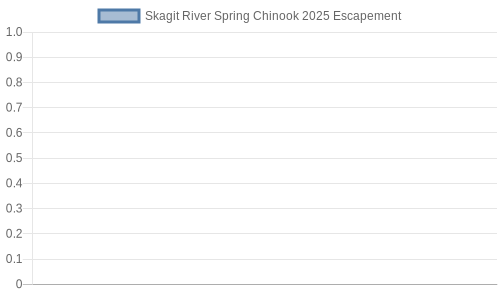
The above graph will update every Thursday typically.
When to fish for spring chinook on the Skagit River?
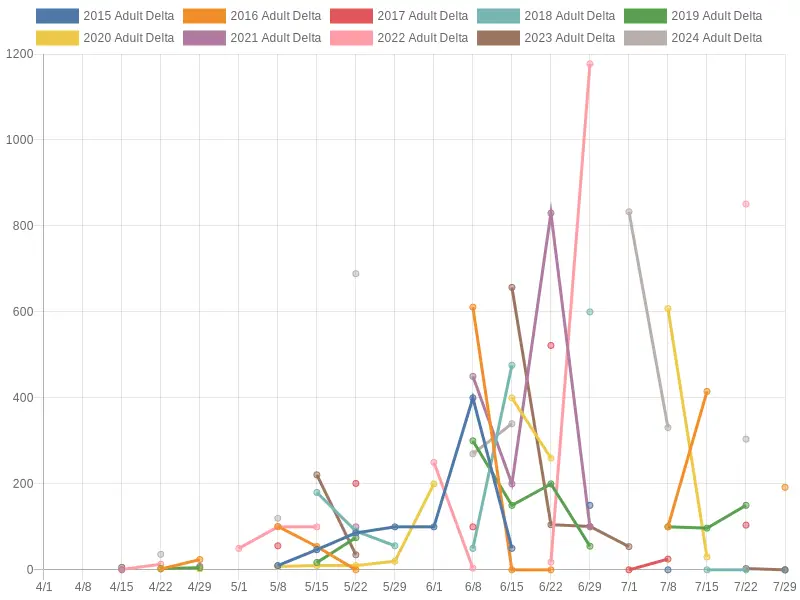
When looking at a chart like the above, you want to visually ascertain when the run really begins to be fishable in most years. The Marblemount hatchery where the Skagit Spring chinook are headed for is about 80 miles from where the river dumps into Skagit Bay.
Early on in a run, spring chinook in particular, like summer steelhead are not urgently making their way upriver, which means they will be in the lower section of the river a considerable time prior to any escapement report.
There are likely enough spring chinook to fish on by mid to late April in the lower river, but the run may slow down considerably by mid-June.
The midway and end of a run spends less time in the river and those fish will have more urgency in making it to the hatchery.
Forecast for 2025 Skagit River Spring Chinook
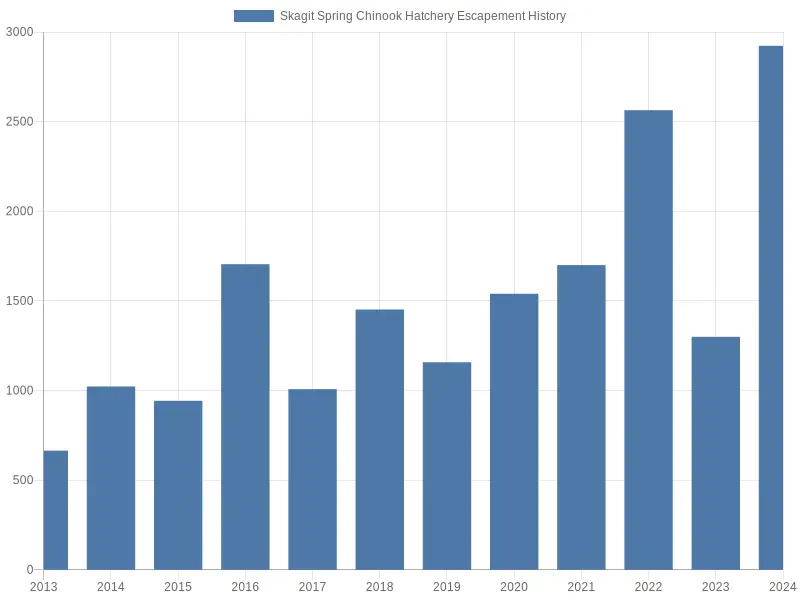
The run of hatchery spring chinook on the Skagit River has been surprisingly stable compared to many runs of anadromous fish in the past 10 years.
Where are we expected to be in 2025 though?
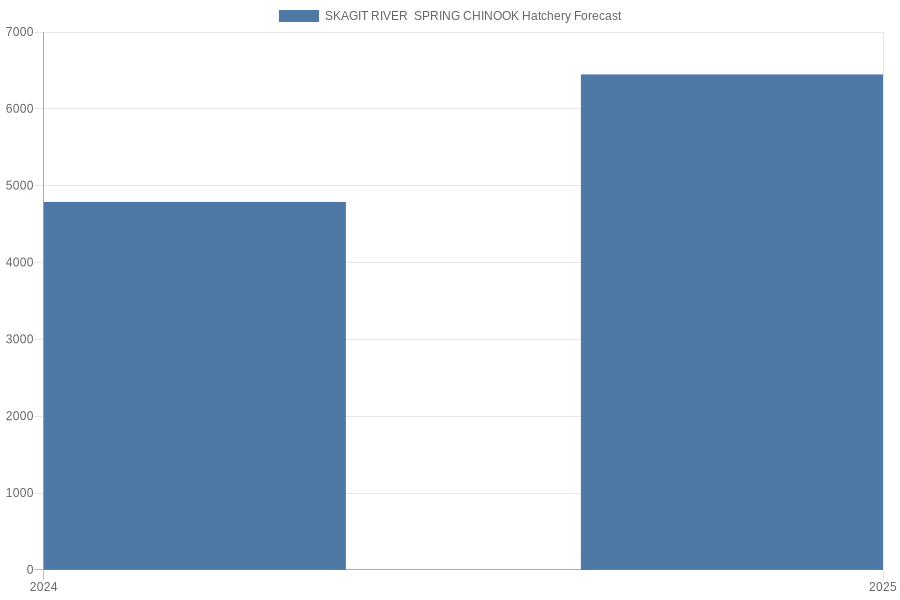
The run-size for hatchery marked Skagit Spring Chinook in 2025 is forecasted to be around 6500 fish. I was able to do one trip in 2024 on the Cascade River and I may have to make another trip up here with an even better forecast in 2025.
Skagit River Salmon Fishing 2024
Here’s an account of where we are right now though in this run:
Updated status on hatchery coho returning to the Skagit River
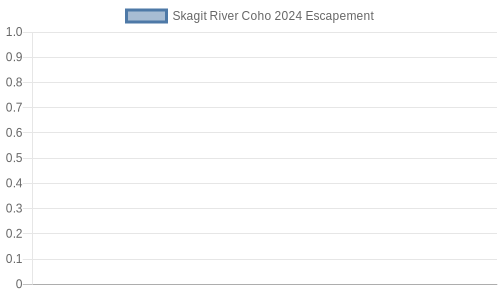
The above graph will update every Thursday typically, with the first coho usually arriving to the hatchery in the first half of September.
When to fish for coho on the Skagit River?

When looking at a chart like the above, you want to visually ascertain when the run really begins to be fishable in most years. The Marblemount hatchery where the Skagit Spring coho are headed for is about 80 miles from where the river dumps into Skagit Bay.
There will be coho present in the lower river in late August and certainly by the first week of September. The graph is only capturing when they arrive at the hatchery and the early part of a salmon run typically will spend more time in the river compared to later in the run when they charge upriver with much more urgency.
Forecast for 2024 Skagit River Coho

After several very challenging middle-late 2010’s, the Skagit river coho run starting in 2020 has really rebounded driving great in-river fisheries and prolific North Puget Sound opportunities.
Where are we expected to be in 2024 though?
According to the PFMC Data Sheet presented at this year’s North of Falcon, the Skagit Coho return is supposed to be around 63,000 hatchery fish and 27,000 natural spawners. Wow! If accurate, this would be one of the best runs of the past decade.
Skagit River Winter Steelhead Fishing 2025
The history of the Skagit River steelhead run is filled with legends of giant wild steelhead and enormous runs of fish. Sadly today’s run is only a fraction of what it used to be.
Planting of hatchery steelhead was discontinued in 2017 after a long history dating back many decades.
Some biologists believe the wild run of steelhead was 75,000 fish or perhaps even greater prior to the arrival of Euro-Americans settling the Skagit Valley and eventually building the three dams which block some critical spawning habitat.
Only just recently in 2023 Seattle City Light has agreed to provide fish passage to this lost spawning habitat.
There is a catch-and-release fishing season allowed on some years based on specific criteria:
“Wild Puget Sound steelhead have been listed as threatened under the Endangered Species Act (ESA) since 2007. When projected returns to the Skagit Basin are 4,000 or fewer fish, under a federally-approved fisheries management plan the number of allowable impacts to those fish is substantially restricted.”
https://wdfw.medium.com/fishing-for-wild-steelhead-will-not-open-on-skagit-river-with-too-few-fish-forecasted-to-return-3a29be518298
Factors impacting the recovery of more wild steelhead on the Skagit and other Puget Sound rivers are diverse and complex. Reduced spawning habitat is only part of the picture.
Ocean conditions and predation are likely significant factors with marine mammal predation having some strong recent scientific findings providing clear indications of the massive impact on steelhead and salmon runs.
Fishing Regulations on the Skagit River for 2024-2025
| Species | Date | Additional Rules |
from the mouth (a line projected from the terminus of the jetty with McGlinn Island to the white monument on the easterly end of Ika Island, then to a white monument on the westerly end of Craft Island, then to a white monument near the corner of the levee on the westerly side of Dry Slough, and then to a white monument on the easterly side of Tom Moore Slough) to Hwy. 536 at Mt. Vernon (Memorial Hwy. Bridge) CRC (830) |
||
All species |
Mar. 1-Aug. 13 |
Selective gear rules. Except: Anglers fishing for sturgeon must use bait. Anglers may not use hooks that measure greater than 1/2” from point to shank, except anglers fishing for sturgeon may use single-point barbless hooks of any size. |
Aug. 14-Oct. 31 |
Night closure. |
|
Dolly varden/bull trout |
Mar. 1-Jan. 31 |
Min. size 20”. May be retained as part of trout daily limit. |
Other trout |
Mar. 1-Jan. 31 |
Statewide min. size/daily limit. Except: Cutthroat trout and wild rainbow trout min. size 14”. |
Other game fish |
Mar. 1-Jan. 31 |
Statewide min. size/daily limit. |
Salmon |
Sept. 1-Oct. 31 |
Min. size 12”. Daily limit 2. Release Chinook and chum. |
from Hwy. 536 at Mt. Vernon (Memorial Hwy. Bridge) to mouth of Gilligan Creek CRC (830) |
||
All species |
June 1-Aug. 13 |
Selective gear rules. Except: Anglers fishing for sturgeon must use bait. Anglers may not use hooks that measure greater than 1/2” from point to shank, except anglers fishing for sturgeon may use single-point barbless hooks of any size. |
June 16-July 15 |
Night closure. |
|
Aug. 14-Oct. 31 |
Night closure. |
|
Dolly varden/bull trout |
June 1-Jan. 31 |
Min. size 20”. May be retained as part of trout daily limit. |
Other trout |
June 1-Jan. 31 |
Statewide min. size/daily limit. Except: Cutthroat trout and wild rainbow trout min. size 14”. |
Other game fish |
June 1-Jan. 31 |
Statewide min. size/daily limit. |
Salmon |
July 1-July 15 |
Min. size 12”. Daily limit 4. Release all salmon other than sockeye. |
Sept. 1-Oct. 31 |
Min. size 12”. Daily limit 2. Release Chinook and chum. |
|
from mouth of Gilligan Creek to the Dalles Bridge at Concrete CRC (830) |
||
All species |
June 1-Aug. 31 |
Selective gear rules. Night closure. It is unlawful to use hooks other than those measuring 1/2” or less from point to shank. |
Sept. 1-Sept. 30 |
Single-point barbless hooks required. Bait prohibited. Night closure. |
|
Oct. 1-Oct. 31 |
Night closure. |
|
Dolly varden/bull trout |
June 1-Jan. 31 |
Min. size 20”. May be retained as part of trout daily limit. |
Other trout |
June 1-Jan. 31 |
Statewide min. size/daily limit. Except: Cutthroat trout and wild rainbow trout min. size 14”. |
Other game fish |
June 1-Jan. 31 |
Statewide min. size/daily limit. |
Salmon |
July 1-July 15 |
Min. size 12”. Daily limit 4. Release all salmon other than sockeye. |
Sept. 1-Oct. 31 |
Min. size 12”. Daily limit 2. Release Chinook and chum. |
|
from the Dalles Bridge at Concrete to 200’ below the mouth of Baker River CRC (830) |
||
All species |
June 1-Sept. 15 |
Selective gear rules. Night closure. It is unlawful to use hooks other than those measuring 1/2” or less from point to shank. |
Sept. 16-Sept. 30 |
Night closure. Bait prohibited. Single-point barbless hooks required. |
|
Oct. 1-Oct. 31 |
Night closure. |
|
Dolly varden/bull trout |
June 1-Jan. 31 |
Min. size 20”. May be retained as part of trout daily limit. |
Other game fish |
June 1-Jan. 31 |
Statewide min. size/daily limit. |
Salmon |
Sept. 16-Oct. 31 |
Min. size 12”. Daily limit 2. Release Chinook and chum. |
between a line projected across the thread of the river 200’ above the east bank of the Baker River and a line projected across the thread of the river 200’ below the west bank of the Baker River CRC (830) |
||
All species |
June 1-Sept. 15 |
CLOSED WATERS. |
Sept. 16-Sept. 30 |
Single-point barbless hooks required. Bait prohibited. Night closure. |
|
Oct. 1-Oct. 31 |
Night closure. |
|
Dolly varden/bull trout |
Sept. 16-Jan. 31 |
Min. size 20”. May be retained as part of trout daily limit. |
Other trout |
Sept. 16-Jan. 31 |
Statewide min. size/daily limit. Except: Cutthroat trout and wild rainbow trout min. size 14”. |
Other game fish |
Sept. 16-Jan. 31 |
Statewide min. size/daily limit. |
Salmon |
Sept. 16-Oct. 31 |
Min. size 12”. Daily limit 2. Release Chinook and chum. |
from a point 200’ upstream of the mouth of the Baker River to the Hwy. 530 Bridge at Rockport CRC (830) |
||
All species |
June 1-Sept. 15 |
Selective gear rules. Night closure. Anglers may not use hooks that measure greater than 1/2” from point to shank. |
Sept. 16-Sept. 30 |
Single-point barbless hooks required. Bait prohibited. Night closure. |
|
Oct. 1-Oct. 31 |
Night closure. |
|
Dolly varden/bull trout |
June 1-Jan. 31 |
Min. size 20”. May be retained as part of trout daily limit. |
Other trout |
June 1-Jan. 31 |
Statewide min. size/daily limit. Except: Cutthroat trout and wild rainbow trout min. size 14”. |
Other game fish |
June 1-Jan. 31 |
Statewide min. size/daily limit. |
Salmon |
Sept. 16-Oct. 31 |
Min. size 12”. Daily limit 2. Release Chinook and chum. |
from Hwy. 530 Bridge at Rockport to Cascade River Rd. (Marblemount Bridge). CRC (830) |
||
All species |
June 1-July 15 |
Anti-snagging rule. Night closure. |
July 16-Sept. 15 |
Night closure. Selective gear rules. Anglers may not use hooks that measure greater than 1/2” from point to shank. |
|
Sept. 16-Sept. 30 |
Night closure. Bait prohibited. Single-point barbless hooks required. |
|
Oct. 1-Oct. 31 |
Night closure. |
|
All game fish |
June 1-Jan. 31 |
Statewide min. size/daily limit. |
Salmon |
July 1-July 15 |
Min. size 12”. Daily limit 4 including no more than 2 adults. Release all salmon other than hatchery Chinook. |
Sept. 16-Oct. 31 |
Min. size 12”. Daily limit 2. Release Chinook and chum. |
|
from Cascade River Rd. (Marblemount Bridge) to Gorge powerhouse at Newhalem CRC (830) |
||
All species |
Internal combustion motors prohibited. Selective gear rules. |
|
All game fish |
June 1-Jan. 31 |
Catch and Release. Except: 2 hatchery steelhead may be retained. |
Note: These fishing regulations do not include the portions of the Skagit River above the confluence with the Cascade River.
Please refer to WDFW’s emergency rules page for a full list of rules that are in effect.
It’s your responsibility as the recreational angler to know ALL of these rules, not just what is discussed here on the blog.